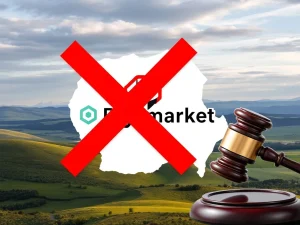Wyoming Stablecoin’s Strategic Leap: FRNT Lands on Hedera Blockchain

The digital asset landscape constantly evolves. Therefore, a new development has captured significant attention: the **Wyoming stablecoin** FRNT is now expanding its reach to the **Hedera blockchain**. This move marks a pivotal moment for state-backed digital currencies and for enthusiasts tracking the growth of secure, compliant stablecoins.
Wyoming Stablecoin: A Unique State-Backed Digital Asset
The Frontier Stable Token, or **FRNT stablecoin**, stands out in the cryptocurrency world. It is a stablecoin authorized directly by the US state of Wyoming. Consequently, this unique backing lends it a distinct level of authority and trust. The Wyoming Stable Token Commission oversees its issuance. This body ensures compliance and security, setting a precedent for state involvement in digital finance. Initially, the **FRNT stablecoin** reportedly launched on seven different blockchains in August. These included major networks such as Ethereum, Solana, Arbitrum, Avalanche, Polygon, Optimism, and Base. This broad initial deployment underscored the project’s ambition to achieve wide accessibility from its inception.
Hedera Blockchain Joins the FRNT Ecosystem
In a recent announcement, the **Hedera blockchain** confirmed its selection as a candidate for FRNT. This decision followed a thorough review of various possible networks by the Wyoming Stable Token Commission. Furthermore, the Commission formally approved the proposal. Anthony Apollo, executive director of the Wyoming Stable Token Commission, emphasized the rationale behind this choice. He stated, “The Commission selected Hedera for candidacy because its technical edge aligns with our commitment to security and compliance.” Therefore, Hedera’s inclusion represents a strategic expansion for the **Wyoming stablecoin**, enhancing its foundational technology and market reach.
Why Hedera? Security and Compliance
Hedera’s selection highlights its robust technical capabilities. The network offers high transaction speeds, low fees, and enterprise-grade security. These features are crucial for a stablecoin aiming for widespread adoption and regulatory adherence. Moreover, Hedera’s unique hashgraph consensus mechanism provides a high degree of finality and resistance to attacks. This makes it an attractive platform for financial instruments like stablecoins. Consequently, the integration with **Hedera blockchain** further solidifies FRNT’s commitment to a secure and compliant digital ecosystem. This move ensures that the **FRNT stablecoin** can operate efficiently and reliably, meeting the stringent requirements of a state-backed asset.
The Road to Purchase: Availability and Anticipation
Despite its mainnet launch and multi-chain presence, the **Wyoming stablecoin** is not yet available for public purchase. Many expected FRNT to be purchasable shortly after its August launch. However, the Wyoming Stable Token Commission website still indicates that users do not have this option. Hedera’s announcement also acknowledged this, stating that information on purchasing the coin would be available “soon.” This delay creates anticipation among potential users and investors. Nevertheless, the ongoing developments signal progress toward its eventual public release. The Commission aims to ensure all regulatory and technical aspects are perfectly aligned before enabling public access to the **FRNT stablecoin**.
Wyoming’s Ascent as a US Crypto Hub
Wyoming has firmly established itself as a leading **US crypto hub**. The state has actively pursued pro-crypto policies, distinguishing itself from other jurisdictions. In fact, Wyoming was one of the first states to treat cryptocurrencies as fiat money. This forward-thinking approach has attracted numerous companies and digital asset advocates. For instance, cryptocurrency exchange Kraken announced its decision to move its global headquarters to Cheyenne in June. They cited Wyoming’s “recognition of the pro-crypto policymakers and constructive regulations” as a primary reason. This demonstrates the tangible impact of the state’s supportive environment on the crypto industry.
Kraken’s Move and Policy Impact
Kraken’s relocation underscores Wyoming’s commitment to fostering innovation in the digital asset space. The state’s clear regulatory framework provides certainty for businesses. This contrasts sharply with the often ambiguous federal landscape. Furthermore, Wyoming has hosted significant events that influence **digital asset regulation**. The American Innovation Project, an advocacy group, launched amid a Wyoming conference. During one such event, a Justice Department official suggested a radical change to enforcement cases involving crypto and blockchain. These discussions highlight Wyoming’s pivotal role in shaping the future of **digital asset regulation** across the nation.
Broader Implications for Digital Asset Regulation
The launch and expansion of the **Wyoming stablecoin** have broader implications for **digital asset regulation**. While federal policies under US President Donald Trump may show signs of softening, state governments retain significant authority. Wyoming’s proactive stance demonstrates how states can innovate within the existing legal framework. This dual approach—state-level innovation alongside evolving federal discussions—creates a complex but dynamic regulatory environment. The success of FRNT could encourage other states to explore similar initiatives. Conversely, it might also prompt federal authorities to develop more cohesive national policies. Consequently, the ongoing developments in Wyoming contribute significantly to the national conversation about digital assets and their governance.
In conclusion, the integration of the **FRNT stablecoin** with the **Hedera blockchain** represents a significant milestone. It highlights Wyoming’s continued leadership as a **US crypto hub** and its innovative approach to **digital asset regulation**. As the state-backed stablecoin progresses towards public availability, its journey will undoubtedly offer valuable insights into the future of digital finance and regulatory frameworks. The crypto community eagerly awaits further updates on this pioneering project.








